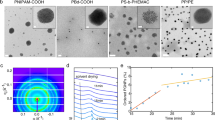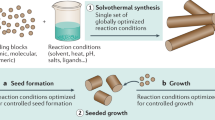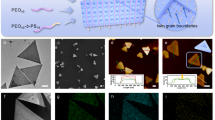Abstract
Whether two species will co-crystallize depends on the chemical, physical and structural complementarity of the interacting components. Here, by using DNA as a surface ligand, we selectively co-crystallize mixtures of two different anisotropic nanoparticles and systematically investigate the effects of nanoparticle size and shape complementarity on the resultant crystal symmetry, microstrain, and effective ‘DNA bond’ length and strength. We then use these results to understand a more complicated system where both size and shape complementarity change, and where one nanoparticle can participate in multiple types of directional interactions. Our findings offer improved control of non-spherical nanoparticles as building blocks for the assembly of sophisticated macroscopic materials, and provide a framework to understand complementarity and directional interactions in DNA-mediated nanoparticle crystallization.
This is a preview of subscription content, access via your institution
Access options
Subscribe to this journal
Receive 12 print issues and online access
$259.00 per year
only $21.58 per issue
Buy this article
- Purchase on Springer Link
- Instant access to full article PDF
Prices may be subject to local taxes which are calculated during checkout




Similar content being viewed by others
References
Bishop, K. J. M., Wilmer, C. E., Soh, S. & Grzybowski, B. A. Nanoscale forces and their uses in self-assembly. Small 5, 1600–1630 (2009).
Jones, M. R., Osberg, K. D., Macfarlane, R. J., Langille, M. R. & Mirkin, C. A. Templated techniques for the synthesis and assembly of plasmonic nanostructures. Chem. Rev. 111, 3736–3827 (2011).
Macfarlane, R. J., O’Brien, M. N., Petrosko, S. H. & Mirkin, C. A. Nucleic acid-modified nanostructures as programmable atom equivalents: Forging a new “table of elements”. Angew. Chem. Int. Ed. 52, 5688–5698 (2013).
Min, Y., Akbulut, M., Kristiansen, K., Golan, Y. & Israelachvili, J. The role of interparticle and external forces in nanoparticle assembly. Nature Mater. 7, 527–538 (2008).
Grzelczak, M., Vermant, J., Furst, E. M. & Liz-Marzán, L. M. Directed self-assembly of nanoparticles. ACS Nano 4, 3591–3605 (2010).
Shevchenko, E. V., Talapin, D. V., Kotov, N. A., O’Brien, S. & Murray, C. B. Structural diversity in binary nanoparticle superlattices. Nature 439, 55–59 (2006).
Park, S. Y. et al. DNA-programmable nanoparticle crystallization. Nature 451, 553–556 (2008).
Nykypanchuk, D., Maye, M. M., van der Lelie, D. & Gang, O. DNA-guided crystallization of colloidal nanoparticles. Nature 451, 549–552 (2008).
Talapin, D. V. et al. Quasicrystalline order in self-assembled binary nanoparticle superlattices. Nature 461, 964–967 (2009).
Dong, A. G., Chen, J., Vora, P. M., Kikkawa, J. M. & Murray, C. B. Binary nanocrystal superlattice membranes self-assembled at the liquid–air interface. Nature 466, 474–477 (2010).
Macfarlane, R. J. et al. Nanoparticle superlattice engineering with DNA. Science 334, 204–208 (2011).
Li, T. I. N. G., Sknepnek, R., Macfarlane, R. J., Mirkin, C. A. & Olvera de la Cruz, M. Modeling the crystallization of spherical nucleic acid nanoparticle conjugates with molecular dynamics simulations. Nano Lett. 12, 2509–2514 (2012).
Macfarlane, R. J., Jones, M. R., Lee, B., Auyeung, E. & Mirkin, C. A. Topotactic interconversion of nanoparticle superlattices. Science 341, 1222–1225 (2013).
Glotzer, S. C. & Solomon, M. J. Anisotropy of building blocks and their assembly into complex structures. Nature Mater. 6, 557–562 (2007).
Jones, M. R. et al. DNA-nanoparticle superlattices formed from anisotropic building blocks. Nature Mater. 9, 913–917 (2010).
Quan, Z. & Fang, J. Superlattices with non-spherical building blocks. Nano Today 5, 390–411 (2010).
Jones, M. R., Macfarlane, R. J., Prigodich, A. E., Patel, P. C. & Mirkin, C. A. Nanoparticle shape anisotropy dictates the collective behavior of surface-bound ligands. J. Am. Chem. Soc. 133, 18865–18869 (2011).
Damasceno, P. F., Engel, M. & Glotzer, S. C. Predictive self-assembly of polyhedra into complex structures. Science 337, 453–457 (2012).
Walker, D. A., Leitsch, E. K., Nap, R. J., Szleifer, I. & Grzybowski, B. A. Geometric curvature controls the chemical patchiness and self-assembly of nanoparticles. Nature Nanotech. 8, 676–681 (2013).
Ye, X. et al. Competition of shape and interaction patchiness for self-assembling nanoplates. Nature Chem. 5, 466–473 (2013).
O’Brien, M. N., Radha, B., Brown, K. A., Jones, M. R. & Mirkin, C. A. Langmuir analysis of nanoparticle polyvalency in DNA-mediated adsorption. Angew. Chem. Int. Ed. 53, 9532–9538 (2014).
Singh, G. et al. Self-assembly of magnetite nanocubes into helical superstructures. Science 345, 1149–1153 (2014).
Boles, M. A. & Talapin, D. V. Self-assembly of tetrahedral CdSe nanocrystals: Effective “patchiness” via anisotropic steric interaction. J. Am. Chem. Soc. 136, 5868–5871 (2014).
Ming, T. et al. Ordered gold nanostructure assemblies formed by droplet evaporation. Angew. Chem. Int. Ed. 47, 9685–9690 (2008).
Sacanna, S., Irvine, W. T. M., Chaikin, P. M. & Pine, D. J. Lock and key colloids. Nature 464, 575–578 (2010).
Ye, X. et al. Shape alloys of nanorods and nanospheres from self-assembly. Nano Lett. 13, 4980–4988 (2013).
Paik, T. & Murray, C. B. Shape-directed binary assembly of anisotropic nanoplates: A nanocrystal puzzle with shape-complementary building blocks. Nano Lett. 13, 2952–2956 (2013).
Kang, Y. et al. Design of Pt–Pd binary superlattices exploiting shape effects and synergistic effects for oxygen reduction reactions. J. Am. Chem. Soc. 135, 42–45 (2012).
Paik, T., Ko, D-K., Gordon, T. R., Doan-Nguyen, V. & Murray, C. B. Studies of liquid crystalline self-assembly of GdF3 nanoplates by in-plane, out-of-plane SAXS. ACS Nano 5, 8322–8330 (2011).
Macfarlane, R. J. et al. Importance of the DNA “bond” in programmable nanoparticle crystallization. Proc. Natl Acad. Sci. USA 111, 14995–15000 (2014).
Jones, M. R., Seeman, N. C. & Mirkin, C. A. Programmable materials and the nature of the DNA bond. Science 347 (2015)10.1126/science.1260901
Macfarlane, R. J. et al. Establishing the design rules for DNA-mediated programmable colloidal crystallization. Angew. Chem. Int. Ed. 49, 4589–4592 (2010).
Auyeung, E. et al. DNA-mediated nanoparticle crystallization into Wulff polyhedra. Nature 505, 73–77 (2014).
O’Brien, M. N., Jones, M. R., Brown, K. A. & Mirkin, C. A. Universal noble metal nanoparticle seeds realized through iterative reductive growth and oxidative dissolution reactions. J. Am. Chem. Soc. 136, 7603–7606 (2014).
O’Brien, M. N., Jones, M. R., Kohlstedt, K. L., Schatz, G. C. & Mirkin, C. A. Uniform circular disks with synthetically tailorable diameters: Two-dimensional nanoparticles for plasmonics. Nano Lett. 15, 1012–1017 (2015).
Senesi, A. & Lee, B. Scattering functions of polyhedra. J. Appl. Cryst. 48, 565–577 (2015).
Auyeung, E., Macfarlane, R. J., Choi, C. H. J., Cutler, J. I. & Mirkin, C. A. Transitioning DNA-engineered nanoparticle superlattices from solution to the solid state. Adv. Mater. 24, 5181–5186 (2012).
Williamson, G. K. & Hall, W. H. X-ray line broadening from filed aluminium and wolfram. Acta Metall. Mater. 1, 22–31 (1953).
Weidenthaler, C. Pitfalls in the characterization of nanoporous and nanosized materials. Nanoscale 3, 792–810 (2011).
Senesi, A. J. et al. Oligonucleotide flexibility dictates crystal quality in DNA-programmable nanoparticle superlattices. Adv. Mater. 26, 7235–7240 (2014).
Jin, R. C., Wu, G. S., Li, Z., Mirkin, C. A. & Schatz, G. C. What controls the melting properties of DNA-linked gold nanoparticle assemblies? J. Am. Chem. Soc. 125, 1643–1654 (2003).
Storhoff, J. J. et al. What controls the optical properties of DNA-linked gold nanoparticle assemblies? J. Am. Chem. Soc. 122, 4640–4650 (2000).
Mergny, J. L. & Lacroix, L. Analysis of thermal melting curves. Oligonucleotides 13, 515–537 (2003).
Zheng, J. et al. Two-dimensional nanoparticle arrays show the organizational power of robust DNA motifs. Nano Lett. 6, 1502–1504 (2006).
Schreiber, R. et al. Hierarchical assembly of metal nanoparticles, quantum dots and organic dyes using DNA origami scaffolds. Nature Nano 9, 74–78 (2014).
Gerling, T., Wagebauer, K. F., Neuner, A. M. & Dietz, H. Dynamic DNA devices and assemblies formed by shape complementary, non-base pairing 3D components. Science 347, 1446–1452 (2015).
Jones, M. R. & Mirkin, C. A. Bypassing the limitations of classical chemical purification with DNA-programmable nanoparticle recrystallization. Angew. Chem. Int. Ed. 52, 2886–2891 (2013).
Acknowledgements
C.A.M. acknowledges support from the following awards: the Air Force Office of Scientific Research (AFOSR) Multidisciplinary University Research Initiative (MURI) FA9550-11-1-0275, the Department of Defense National Security Science and Engineering Faculty Fellowship (NSSEFF) award N00014-15-1-0043, the National Science Foundation (NSF) Materials Research Science and Engineering Center program DMR-1121262 at the Materials Research Center of Northwestern University, and the Non-equilibrium Energy Research Center (NERC)—an Energy Frontier Research Center funded by the Department of Energy (DoE), Office of Science, and Office of Basic Energy Sciences under Award DE-SC0000989. M.N.O. and M.R.J. are grateful to the NSF for Graduate Research Fellowships. SAXS experiments were carried out at the Dupont–Northwestern–Dow Collaborative Access Team beamline at the Advanced Photon Source (APS) at Argonne National Laboratory, and use of the APS was supported by the DoE (DE-AC02-06CH11357). This work made use of the EPIC facility (NUANCE Center-Northwestern University), which has received support from the MRSEC programme (NSF DMR-1121262) at the Materials Research Center, and the Nanoscale Science and Engineering Center (EEC-0118025/003), both programmes of the National Science Foundation, the State of Illinois and Northwestern University. We thank K. A. Brown and A. J. Senesi for helpful discussions.
Author information
Authors and Affiliations
Contributions
M.N.O., M.R.J., B.L. and C.A.M. designed the experiments and analysed data. M.N.O. prepared samples and collected EM, ultraviolet–visible and SAXS data. B.L. wrote the theoretical model and the simulation details found in the Supplementary Information. M.N.O. and C.A.M. wrote the manuscript. B.L. and M.R.J. edited the manuscript.
Corresponding authors
Ethics declarations
Competing interests
The authors declare no competing financial interests.
Supplementary information
Supplementary Information
Supplementary Information (PDF 13216 kb)
Rights and permissions
About this article
Cite this article
O’Brien, M., Jones, M., Lee, B. et al. Anisotropic nanoparticle complementarity in DNA-mediated co-crystallization. Nature Mater 14, 833–839 (2015). https://doi.org/10.1038/nmat4293
Received:
Accepted:
Published:
Issue Date:
DOI: https://doi.org/10.1038/nmat4293
This article is cited by
-
Complex assemblies and crystals guided by DNA
Nature Materials (2020)
-
De novo nanomaterial crystals from DNA frameworks
Nature Materials (2020)
-
Directional Assembly of Nanoparticles by DNA Shapes: Towards Designed Architectures and Functionality
Topics in Current Chemistry (2020)
-
Crystal engineering with DNA
Nature Reviews Materials (2019)
-
Autonomous dynamic control of DNA nanostructure self-assembly
Nature Chemistry (2019)



